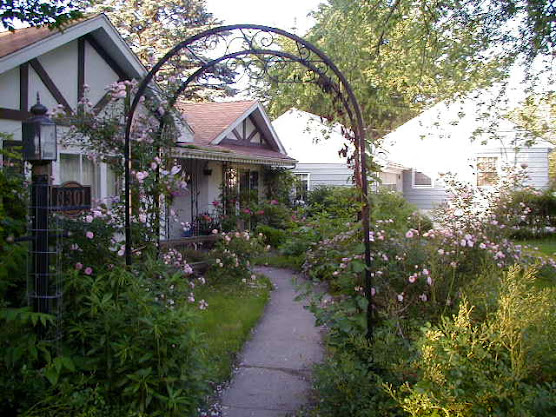Thorny rugosa roses can fortify garden boundaries
By
Amy McDowell
It was an otherwise quiet evening at the
garden center. The after-work crowd had slowed as people headed home for
dinner. The summer sun far in the western sky cast long shadows across the
parking lot. I was monkeying with the bird feeder display when the bell on the
door jangled, and I turned to greet a well-dressed woman in a tailored brown
business suit. She approached with a frown.
“Do you sell poison ivy plants?” she asked.
“Poison ivy?” Surely I had heard her wrong.
She must’ve said Boston ivy.
“Yes, poison ivy,” she said. “Can I buy
poison ivy plants?”
I lifted my eyebrows and mentally reminded
myself how stupid I look standing with my mouth hanging open. “Um, no, we don’t
sell poison ivy,” I said, studying her brown eyes closely for signs of
insanity.
“Oh.” Her shoulders fell a little. “Then how
about seeds? Do you sell poison ivy seeds?”
“Uh, no.” I said, and finally caved in to my
bafflement and asked why she wanted to grow poison ivy.
“It’s my neighbors,” she said. “They’re
always cutting through my back yard. It’s even fenced and they climb right over!” She waved her flawless painted
nails in the air and her diamond ring glittered under the fluorescent lights.
“I yell at them and they act like they don’t understand English,” she said,
“but I know they’d understand the international language of ITCH.”
I breathed a sigh of relief. She was not a
lunatic, just bonkers and sick of being trespassed. When I couldn’t help her,
she left the store exasperated.
I’ve since come up with the perfect remedy…
rugosa roses. These fast-growing beauties are covered with barbaric thorns. The
stiff stems are ferocious from ground to tip. Rugosas form a rounded thicket
four to six feet tall and wide. Planted three or four feet apart, they make an
impenetrable hedge.
Better yet, the fragrant fuschia, pink or
white blooms in the summer are followed by red or orange rose hips in the fall.
In Latin, ‘rugosa’ means ‘wrinkled,’ a name fitting the crinkled dark green
foliage. Fall color is usually short lived and yellow, but some rugosas turn
orange or red. Rugosas are among the most disease free of all roses, so they
don’t need any pesticide sprays. Annual deadwood pruning in spring is the only
care they require.
Rugosas prefer well-drained soil in full sun
or light shade. Hardy from zones 2-7, rugosas are wintertime tough. They’ve
“been seen 100 miles from the Arctic Circle in Siberia where the temperature
regularly falls to –50 degrees Fahrenheit,” writes woody plantsman Michael Dirr
in his Manual of Woody Landscape Plants, 1990, Stipes Publishing Co.
Because of their vigor and easy care,
rugosas are used in hybridization programs for new roses.
Next time someone asks me about poison ivy
to keep interlopers from the yard, I’ll be ready with a suggestion. The wicked
prickly thorns of beautiful rugosa roses will keep even the most brazen
intruders at bay.




